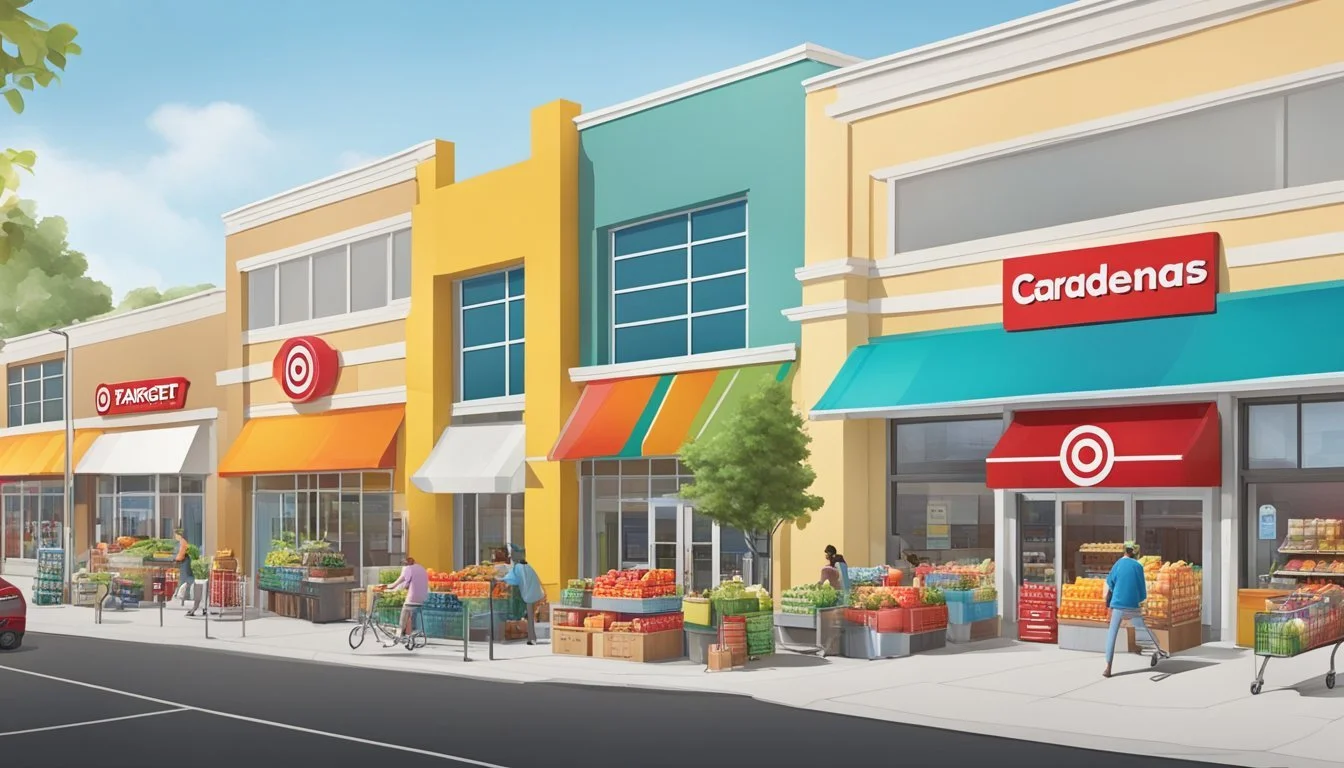Target vs Cardenas Markets
Comparing Prices, Selection, and Experience
Target and Cardenas Markets cater to different grocery shopping needs and preferences. Target offers a wide range of general merchandise alongside its grocery selection, appealing to shoppers seeking convenience and variety. Cardenas Markets, on the other hand, specializes in Hispanic and Latin American products, providing an authentic cultural shopping experience.
The choice between Target and Cardenas Markets depends on individual preferences, cultural background, and specific grocery needs. Target excels in providing a one-stop shopping experience with its diverse product range, while Cardenas Markets offers a unique selection of fresh produce, meats, and specialty items that are particularly appealing to those seeking Latin American flavors.
Both stores have their strengths in terms of shopping experience. Target's clean, organized layout and modern amenities attract shoppers looking for a streamlined grocery trip. Cardenas Markets creates a vibrant atmosphere with its focus on fresh ingredients and cultural authenticity, drawing customers who value traditional Hispanic products and flavors.
Company Backgrounds
Target and Cardenas Markets represent two distinct approaches to grocery retail in the United States. These companies have unique histories that shaped their current market positions and customer bases.
History of Target
Target Corporation began in 1902 as Goodfellow Dry Goods in Minneapolis, Minnesota. The company rebranded as Target in 1962, launching its first discount store in Roseville, Minnesota.
Target rapidly expanded across the country, becoming a major national chain. By the 1990s, it had established itself as a trendy, affordable alternative to Walmart.
The company introduced its grocery section, SuperTarget, in 1995. This move expanded Target's offerings to include fresh produce and perishables.
Target's growth continued through the 2000s and 2010s. It now operates over 1,800 stores across the United States, offering a mix of general merchandise and groceries.
History of Cardenas Markets
Cardenas Markets was founded in 1981 by Jesús Cárdenas and his wife Luz in Ontario, California. The company started as a small meat market catering to the Hispanic community.
Recognizing the demand for authentic Latin American products, Cardenas Markets expanded its offerings. It grew steadily throughout Southern California in the 1990s and 2000s.
In 2016, private equity firm KKR acquired a majority stake in Cardenas Markets. This investment fueled further expansion and acquisitions.
Cardenas Markets now operates over 50 stores across California, Nevada, and Arizona. It remains focused on serving Hispanic communities with a wide range of ethnic products and fresh produce.
Store Locations and Accessibility
Target and Cardenas Markets have distinct geographic footprints, influencing their accessibility to different customer bases. Their store locations reflect contrasting strategies in market presence and regional focus.
Target's Geographic Presence
Target boasts a widespread national presence with stores across the United States. The retailer operates over 1,900 locations, covering all 50 states. Target's expansion strategy includes a mix of urban, suburban, and rural locations.
In major metropolitan areas like Los Angeles, New York, and Chicago, Target offers multiple store formats. These include full-size stores, smaller city Target locations, and campus stores near universities.
Target's accessibility is enhanced by its focus on remodeling existing stores and opening new locations. The company has invested heavily in store upgrades, completing over 1,000 remodels to date.
Cardenas Markets' Regional Footprint
Cardenas Markets maintains a more focused regional presence, primarily serving Latino communities in the southwestern United States. The grocery chain operates approximately 50 stores across three states: California, Arizona, and Nevada.
California hosts the majority of Cardenas Markets stores, with a strong presence in Southern California and the Central Valley. Key markets include Los Angeles, San Bernardino, and Riverside counties.
In Arizona, Cardenas Markets has established a foothold in the Phoenix metropolitan area. Nevada locations are concentrated in Las Vegas, catering to the city's significant Latino population.
Cardenas Markets' strategy prioritizes areas with large Hispanic populations, ensuring cultural relevance and product offerings aligned with community preferences.
Product Selection and Availability
Target and Cardenas Markets offer distinct grocery selections tailored to different customer needs. Target provides a wide array of mainstream products, while Cardenas Markets specializes in Hispanic and Latin American offerings.
Variety of Groceries at Target
Target's grocery department stocks a diverse range of products to meet general household needs. The store carries national brands, Target-exclusive labels, and organic options. Fresh produce includes common fruits and vegetables, with some organic choices available. The meat section offers standard cuts of beef, pork, and poultry. Target's bakery provides fresh bread, pastries, and cakes.
Dairy products include milk, cheese, yogurt, and eggs from well-known brands. The store's packaged goods selection covers cereals, snacks, canned goods, and frozen foods. Target also stocks household essentials and personal care items alongside groceries.
Specialized Selection at Cardenas Markets
Cardenas Markets focuses on Hispanic and Latin American products, creating a unique shopping experience. The produce section showcases a wide variety of tropical fruits and vegetables, including hard-to-find items like nopales and chayote. Fresh meat counters offer cuts popular in Latin American cuisine, such as thin-sliced carne para asar.
The bakery department features authentic Mexican sweet bread, tortillas, and specialty cakes. Cardenas stocks an extensive selection of Hispanic cheeses, cremas, and other dairy products. The store's aisles are filled with Latin American packaged goods, spices, and imported favorites. Cardenas Markets also carries some mainstream American brands to complement its specialized offerings.
Quality and Freshness
Target and Cardenas Markets differ significantly in their approach to fresh food offerings. Each store caters to distinct customer preferences through their produce, meats, bakery, and deli selections.
Fresh Produce and Meats
Target emphasizes convenience with pre-packaged produce and a limited selection of fresh meats. Their produce section typically features common fruits and vegetables, often pre-cut or bagged for quick grab-and-go shopping.
Cardenas Markets shines in this area. They offer a wide array of fresh produce, including many Latin American fruits and vegetables not commonly found in mainstream stores. Their meat department is expansive, with butchers on-site to provide custom cuts.
Seafood options at Cardenas Markets tend to be more diverse, including whole fish and specialty items popular in Hispanic cuisine. Target's seafood selection is generally more limited, focusing on frozen options and a few fresh choices.
Bakery and Deli Comparisons
Target's bakery section usually consists of pre-packaged items and a small selection of freshly baked goods. Their deli offers basic sliced meats and cheeses, with some prepared foods available.
Cardenas Markets excels in this category. Their in-store bakeries produce a variety of fresh breads, pastries, and traditional Latin American baked goods daily. The deli section at Cardenas is extensive, featuring a wide range of meats, cheeses, and prepared foods reflecting Hispanic culinary traditions.
Both stores maintain food safety standards, but Cardenas Markets generally provides a more authentic and diverse fresh food experience. Target focuses on efficiency and convenience in their fresh food departments.
Price Comparison and Value
Target and Cardenas Markets offer distinct pricing strategies and value propositions. Target aims for competitive everyday prices with additional savings opportunities, while Cardenas Markets specializes in Hispanic and Latin American products at reasonable rates.
Everyday Prices and Discounts
Target's pricing is generally competitive across a wide range of products. The retailer's prices average about 11% lower than typical grocery stores. This translates to significant savings for regular shoppers.
Cardenas Markets focuses on providing value in Hispanic and Latin American foods. Their prices on these specialty items are often lower than mainstream supermarkets. However, for general groceries, Cardenas may be slightly higher priced than Target.
Both stores offer regular discounts. Target frequently rotates sales on various items. Cardenas Markets provides weekly specials, particularly on fresh produce and meats.
Deals and Savings Opportunities
Target excels in providing multiple ways to save. The Target Circle loyalty program offers exclusive deals and cashback rewards. Their RedCard credit or debit card provides an additional 5% discount on most purchases.
Target's app features digital coupons and personalized offers. The retailer also price matches competitors, enhancing overall value.
Cardenas Markets offers traditional paper coupons and digital deals through their website and mobile app. They run frequent promotions on cultural staples and seasonal items.
Both stores provide budget-friendly options. Target's Good & Gather brand offers quality at lower prices. Cardenas Markets' bulk sections and family-size packaging cater to cost-conscious shoppers.
Shopping Convenience and Services
Target and Cardenas Markets offer distinct approaches to shopping convenience and services. Each store caters to different customer needs through their layout, navigation, and additional offerings.
Store Layout and Navigation
Target employs a spacious, department-style layout. Wide aisles and clear signage make it easy to find items. The store uses a grid system, with groceries typically located on one side and general merchandise on the other.
Cardenas Markets features a more compact layout focused on food. Produce sections are often near the entrance, with a logical flow through dairy, meats, and packaged goods. The stores emphasize Hispanic and international foods, making navigation intuitive for their target customers.
Target offers digital store maps through their app, helping shoppers locate items quickly. Cardenas Markets relies more on traditional aisle markers and staff assistance for navigation.
Additional Services Offered
Target provides a range of convenient services. These include in-store pickup for online orders, drive-up service, and same-day delivery through Shipt. The Target app offers digital coupons and a mobile payment option called Wallet.
Cardenas Markets focuses on food-related services. Many locations feature in-store taquerias or hot food counters, offering freshly prepared meals. Some stores provide catering services for events.
Both retailers offer online shopping options. Target's e-commerce platform is more developed, with a user-friendly website and app. Cardenas Markets has been expanding its digital presence, but its online services are not as extensive as Target's.
Target's self-checkout lanes are widespread, while Cardenas Markets tends to emphasize personalized service at traditional checkout counters.
Community and Cultural Relevance
Target and Cardenas Markets approach cultural relevance differently, with distinct strategies for serving diverse communities. Their product offerings and store atmospheres reflect varying levels of focus on Hispanic and mainstream American shoppers.
Catering to the Hispanic Community
Cardenas Markets excels in serving Latino communities. The stores feature authentic Latin American products, ingredients, and prepared foods. Fresh tortillas from in-store tortillerias, house-made salsas, and marinated carne asada cater to Hispanic cooking preferences. Spanish-language signage and bilingual staff create a welcoming environment for Spanish-speaking customers.
Target takes a more mainstream approach but has expanded its Hispanic product selection in recent years. Some locations offer dedicated aisles with popular Latin American brands and ingredients. However, the overall store experience remains geared toward a general American audience.
Mainstream and Cultural Product Offerings
Target provides a wide range of mainstream American products across all departments. The store carries major national brands alongside its own private labels. While some Hispanic items are available, they make up a small portion of Target's overall inventory.
Cardenas Markets focuses heavily on Hispanic products but also stocks American staples. The produce section features both tropical fruits and common vegetables. Aisles contain a mix of Latin American brands and mainstream options. This approach allows Cardenas to serve as a one-stop shop for Hispanic families while attracting a diverse customer base.
Customer Experience
Target and Cardenas Markets offer distinct shopping experiences tailored to their customer bases. Both retailers prioritize customer satisfaction but take different approaches to achieve it.
In-Store Customer Service
Target emphasizes a clean, organized store layout with wide aisles and clear signage. Employees are trained to be helpful and approachable, often assisting customers in locating items. Self-checkout options are available for quick purchases.
Cardenas Markets focuses on creating a welcoming atmosphere for Hispanic shoppers. Staff members are typically bilingual, providing assistance in both English and Spanish. The stores feature vibrant decor and cultural touches, making customers feel at home.
Target generally receives positive reviews for its customer service, with many shoppers appreciating the friendly staff and efficient checkout process. Cardenas Markets is praised for its personalized service and cultural understanding.
Loyalty Programs and Engagement
Target's loyalty program, Target Circle, offers personalized deals, cashback rewards, and exclusive offers. Members earn 1% on purchases and receive birthday discounts. The program integrates seamlessly with Target's mobile app, allowing easy access to savings and digital coupons.
Cardenas Markets' loyalty program provides weekly specials and personalized offers based on shopping habits. Members earn points on purchases, which can be redeemed for discounts on future shopping trips.
Target's program is more technologically advanced, with features like in-app scanning for additional deals. Cardenas Markets' program focuses on providing value through culturally relevant offers and promotions tailored to its customer base.
Both retailers use their loyalty programs to gather customer data, enabling them to refine their product offerings and marketing strategies.
Sustainability and Health Initiatives
Target and Cardenas Markets have distinct approaches to sustainability and health initiatives. Their efforts in organic offerings, eco-friendly practices, support for local farmers, and overall health impact differ significantly.
Organic Offerings and Eco-friendly Practices
Target has expanded its organic product range under its Good & Gather brand. This line includes over 2,000 items, many of which are organic and made without artificial flavors, synthetic colors, or high fructose corn syrup.
Target has also implemented sustainability measures in its stores. The company aims to achieve net-zero greenhouse gas emissions by 2040. It has installed LED lighting and energy-efficient HVAC systems in many locations.
Cardenas Markets focuses on fresh, natural ingredients rather than organic certification. The store emphasizes traditional Hispanic foods and ingredients. While not explicitly marketed as eco-friendly, many of their products are minimally processed.
Support for Local Farmers and Health Impact
Target partners with local farmers through its regional distribution centers. This strategy reduces transportation emissions and supports local economies. The company also offers a wide range of health-focused products, including plant-based alternatives and low-sodium options.
Cardenas Markets strongly supports local Hispanic farmers and producers. This approach ensures fresh, culturally relevant produce and products. The store's emphasis on traditional ingredients and cooking methods aligns with the health benefits associated with Mediterranean and Latin American diets.
Both stores offer fresh produce sections, but Cardenas Markets typically provides a wider variety of tropical fruits and vegetables popular in Hispanic cuisine.
Market Position and Future Outlook
Target and Cardenas Markets occupy distinct positions in the grocery retail landscape. Their strategies and growth trajectories reflect different market approaches and customer bases.
Target's Retail Dominance
Target stands as a major player in the U.S. retail sector. With over 1,800 stores nationwide, the company has a strong market presence. Target's grocery offerings complement its broader merchandise mix, attracting diverse shoppers.
In recent quarters, Target has shown positive comparable-store sales growth. The retailer posted a 4.8% increase, exceeding expectations of 4.18%. This performance demonstrates Target's ability to adapt to changing consumer preferences.
Target continues to invest in its grocery segment. The company focuses on expanding its selection of pantry staples and fresh produce. Its omnichannel strategy integrates in-store and online shopping experiences.
Cardenas Markets' Growth and Expansion
Cardenas Markets, while smaller, has carved out a niche in Hispanic communities. The chain operates over 50 stores across California, Nevada, and Arizona. Its focus on culturally relevant products sets it apart from mainstream retailers.
Cardenas has shown steady growth in recent years. The company expanded its footprint through acquisitions, including Rio Ranch Market stores. This strategy allows Cardenas to enter new markets and increase its customer base.
The retailer's distribution center in Modesto supports its expansion efforts. This facility enhances Cardenas' ability to manage inventory and supply its growing store network efficiently. The company's future outlook includes further expansion in its core markets.











